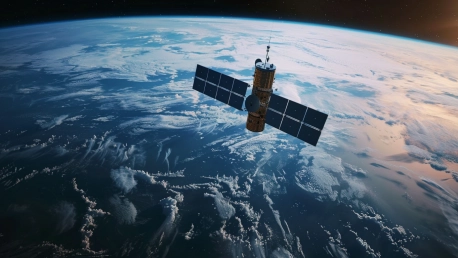In today’s digital age, internet connectivity is more vital than ever. However, significant disparities remain, especially in developing countries. Satellite networks offer a promising solution to these connectivity challenges, enabling global communication even in the most remote areas. Yet, the implementation and operation of satellite networks come with their own set of challenges and opportunities. As the space industry experiences significant expansion, satellite networks emerge as pivotal players in addressing the asymmetric distribution of internet connectivity across the globe and meeting the ever-growing demand for bandwidth.
The Promise of Satellite Connectivity
As the need for global connectivity increases, satellite networks are emerging as a viable solution. Traditional terrestrial networks often face significant economic and infrastructural barriers, particularly in remote or underdeveloped areas. Satellites, however, can provide coverage over vast geographical areas without the need for extensive ground infrastructure. This capability makes them uniquely suited to address the digital divide, bringing internet and communication services to regions that lack access. Furthermore, with rapid technological advancements, satellite networks have become more efficient and cost-effective, promising widespread connectivity.Furthermore, satellite technology has advanced significantly, making it more efficient and cost-effective. The global space industry is booming, valued at nearly half a trillion dollars, suggesting significant investments and developments are anticipated. With satellites, there’s potential to bring about universal connectivity, leveling the playing field for all global citizens. Compared to earlier deployments, satellite networks today can transmit data at higher speeds and with greater reliability, making them an attractive option for both developing and developed regions. This potential for extending internet access universally remains one of the most compelling aspects of satellite networks.
Innovative Technologies Transforming Satellite Communications
One of the most significant advancements in satellite networks is the shift from traditional radio frequency communication to optical communication. By using light to transmit data between satellites, the capacity and security of data transmission are substantially improved. Optical communication enables higher data volumes and is less susceptible to interception, making it ideal for secure transmissions. This development marks a substantial leap in satellite technology, bridging a crucial gap in secure and high-volume data transmission, which is essential for both civilian and defense applications. The speed and integrity of data transmission through optical means are driving significant changes in how we utilize satellite communications.Simultaneously, advancements in ground station technology have facilitated reduced latency in data transmission and reception. These ground stations are crucial for receiving data from satellites and forwarding it to end-users. Reducing latency enhances the real-time interaction capability of satellite networks, making them more effective for applications such as live broadcasts, remote surgeries, and real-time security monitoring. Such improvements in reducing lag times have made satellite internet a competitive alternative to traditional broadband, opening up new possibilities for seamless global communication. The combination of advanced ground stations and optical communication represents a holistic improvement in the operational efficiency of satellite networks.
Diverse Applications of Satellite Networks
Satellite networks are not just about providing internet access. They support a wide array of applications across various sectors. In navigation, satellites enhance GPS services, offering precision location tracking. In environmental monitoring, they provide crucial data for weather forecasting and climate research, enabling better disaster preparedness and response. For instance, global positioning systems (GPS) and weather prediction models heavily rely on satellite data, proving indispensable in both everyday navigation and anticipating severe weather events. These applications illustrate how embedded satellite technology is in modern infrastructures.In agriculture, precision farming powered by satellite-enabled remote sensing allows farmers to optimize crop yields and manage resources more efficiently. Satellites contribute significantly to military operations as well, providing secure communication channels and intelligence-gathering capabilities essential for modern warfare. Beyond military and agricultural applications, satellites are invaluable in disaster response, providing critical real-time data to facilitate rescue operations. For example, during natural disasters like hurricanes or earthquakes, satellite imagery and communication capabilities are crucial for effective response and coordination, demonstrating the wide-reaching utility of satellite networks across different domains.
Challenges in the Space Environment
Despite their advantages, satellites face numerous challenges in the harsh space environment. One significant issue is temperature extremes. Satellites must operate reliably in the fluctuating temperatures of space, necessitating engineering solutions to manage heat and cold effectively. Radiation poses another risk, potentially damaging satellite electronics and affecting performance. Engineers must design satellites to withstand these conditions, often using materials and components resistant to radiation. The harsh environment of space demands innovations in materials science and engineering to maintain satellite functionality over the long term.Moreover, space debris is a growing concern. Collisions with this debris can damage satellites, impairing their functionality. Ensuring satellites’ longevity and reliability involves addressing these various environmental challenges. The accumulation of space junk poses a significant risk to operations, leading to increased efforts in tracking and mitigating potential collisions. Additionally, outgassing, which involves the release of trapped gases in materials, can affect satellites’ precision and accuracy. These challenges underscore the complexity of ensuring optimal satellite performance and the need for continuous innovations in spacecraft design and engineering.
Engineering Trade-offs and Testing
Engineers often face difficult trade-offs when designing satellites to meet the required performance standards while withstanding space’s harsh conditions. Factors such as latency, capacity, signal power, and robustness must be meticulously balanced. Through rigorous laboratory testing, engineers simulate various scenarios to ensure that satellites can handle space’s rigors. Testing includes simulating temperature fluctuations, radiation exposure, and potential impacts from space debris. These comprehensive pre-launch evaluations are critical for minimizing the risk of failure once satellites are in orbit, ensuring they perform reliably. The process of testing and validation is vital in ensuring that deployed satellites meet high standards of resilience and functionality.By addressing these potential issues before deployment, the risk of in-orbit failures is minimized, thereby enhancing the reliability and performance of satellite networks. The iterative process of testing and improvement optimizes satellite design for durability and efficiency. In essence, engineering trade-offs involve compromising on certain parameters to enhance others, always aiming to maximize overall system performance. This methodology ensures that satellites can operate effectively under the unpredictable challenges posed by the space environment, reinforcing the robustness of global satellite networks designed to deliver consistent connectivity.
Future Prospects and Innovations
In today’s digital era, internet connectivity has become immensely crucial. However, significant inequalities persist, notably in developing nations. Satellite networks provide an innovative solution to these connectivity issues, enabling global communication even in the most isolated regions. As the space industry continues to expand rapidly, satellite networks emerge as essential players in addressing the uneven distribution of internet access across the globe and catering to the ever-increasing demand for bandwidth. This technology offers numerous opportunities, but it also brings its own challenges. Implementing and operating satellite networks require considerable investments, advanced technology, and international collaboration. Despite these hurdles, the benefits of satellite networks—such as providing internet in places where traditional infrastructure is impractical—make them a critical component of the future of global communication. By bridging the digital divide, satellite networks hold the promise of fostering greater equality and enabling economic and social development worldwide.









